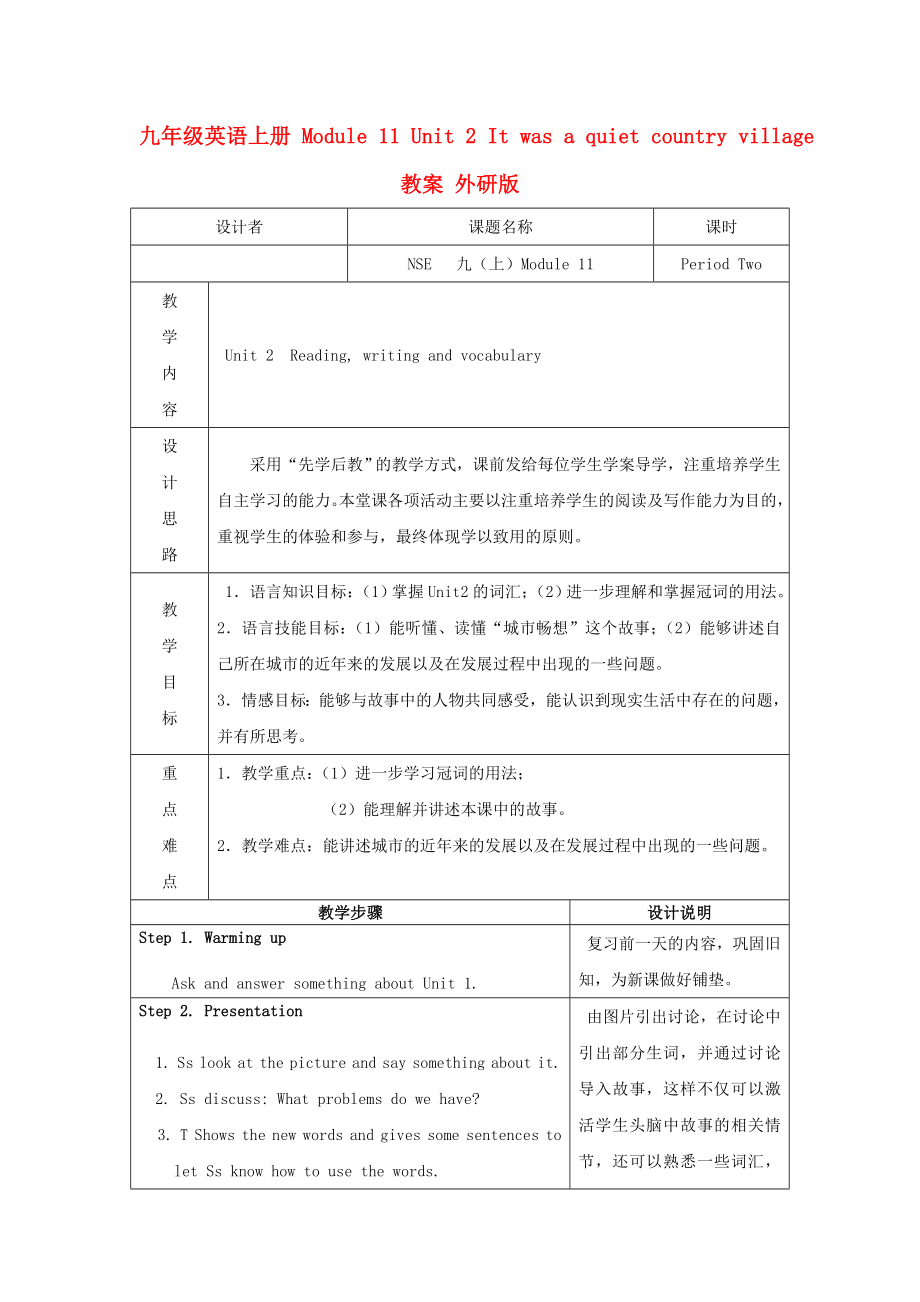《九年級英語上冊 Module 11 Unit 2 It was a quiet country village教案 外研版》由會員分享���,可在線閱讀��,更多相關(guān)《九年級英語上冊 Module 11 Unit 2 It was a quiet country village教案 外研版(3頁珍藏版)》請在裝配圖網(wǎng)上搜索���。
1、九年級英語上冊 Module 11 Unit 2 It was a quiet country village教案 外研版
設(shè)計者
課題名稱
課時
NSE ?九(上)Module 11
Period Two
教
學(xué)
內(nèi)
容
Unit 2 Reading, writing and vocabulary
設(shè)
計
思
路
采用“先學(xué)后教”的教學(xué)方式�����,課前發(fā)給每位學(xué)生學(xué)案導(dǎo)學(xué),注重培養(yǎng)學(xué)生自主學(xué)習(xí)的能力�����。本堂課各項活動主要以注重培養(yǎng)學(xué)生的閱讀及寫作能力為目的�,重視學(xué)生的體驗和參與,最終體現(xiàn)學(xué)以致用的原則�。
教
學(xué)
目
標(biāo)
1.語言知識目標(biāo):(1)掌握
2、Unit 2的詞匯�����;(2)進(jìn)一步理解和掌握冠詞的用法��。
2.語言技能目標(biāo):(1)能聽懂���、讀懂“城市暢想”這個故事�;(2)能夠講述自己所在城市的近年來的發(fā)展以及在發(fā)展過程中出現(xiàn)的一些問題����。
3.情感目標(biāo):能夠與故事中的人物共同感受�����,能認(rèn)識到現(xiàn)實生活中存在的問題,并有所思考��。
重
點
難
點
1.教學(xué)重點:(1)進(jìn)一步學(xué)習(xí)冠詞的用法����;
(2)能理解并講述本課中的故事。
2.教學(xué)難點:能講述城市的近年來的發(fā)展以及在發(fā)展過程中出現(xiàn)的一些問題�����。
教學(xué)步驟
設(shè)計說明
Step 1. Warming up
Ask and answer something about Unit
3��、1.
復(fù)習(xí)前一天的內(nèi)容�����,鞏固舊知�����,為新課做好鋪墊���。
Step 2. Presentation
1. Ss look at the picture and say something about it.
2. Ss discuss: What problems do we have?
3. T Shows the new words and gives some sentences to let Ss know how to use the words.
由圖片引出討論���,在討論中引出部分生詞��,并通過討論導(dǎo)入故事�,這樣不僅可以激活學(xué)生頭腦中故事的相關(guān)情節(jié)�,還可以熟悉一些詞匯,為下一步
4���、閱讀做好準(zhǔn)備�����。
Step 3. Fast reading
●Read the story and answer the following questions.
1. Who was the writer?
2. What changed the writer’s life?
3. How was the writer at last?
快速閱讀�,讓學(xué)生對文章有個初步的理解�����,訓(xùn)練學(xué)生快速閱讀的能力�。
Step 4. Careful reading
●Read the story carefully and answer the questions.
5、
1. How old was Zhang Bei?
2. Where was she?
3.Was she happy or not? Why?
4.What happened one day?
5.What did the boy do?
6.How did Zhang Bei feel?
7.What did she begin to do?
8.What does she think now?
●Choose the best answer
這一步設(shè)計了8個細(xì)節(jié)理解題��,旨在讓學(xué)生細(xì)讀課文�����,達(dá)到既理解故事,又能用自己的語言進(jìn)行表達(dá)的目的��,主要訓(xùn)練學(xué)生的閱讀理
6�、解能力��。
通過此練習(xí)���,讓學(xué)生進(jìn)一步理解課文���。
Step 5. Discussion
●First let Ss discuss the following questions
1. Where do you live?
In the centre of town, in a suburb, in a village or in the countryside?
2. What can you see from your classroom window?
Fields and hills, or blocks of flats and offices?
3. H
7、ow close are you to the nearest shops and the local hospital?
4. Who makes the laws in your town? Who pays the taxes?
5 How much crime is there in your town?
● Then make three suggestions of ways to improve the situation.
讓學(xué)生通過討論認(rèn)識到現(xiàn)實生活中存在的一些問題�,并有所思考,進(jìn)而提出建議��,增強(qiáng)他們的保護(hù)地球的意識����。
Step 6.
8、 Free talk
1.What is your city’s problem?
2. What causes the problem?
3. What to do to help the city?
這一步是語言輸出的過程�����,不僅訓(xùn)練了學(xué)生說的能力����,更重要的是讓學(xué)生綜合運(yùn)用所學(xué)的語言知識���,達(dá)到學(xué)了就用的目的。
Step 7. Writing
? Write about a problem your city has. Use the problems in Activity 5 to help you.
? Cause: more people
? Effect: more shops, more jobs, more visitors,
more serious pollution, more crime, more crowded…
訓(xùn)練學(xué)生的寫作能力
Step 8. Homework
1. Write the passage about the problem and how to improve it.
2. Listen and read after the tape for 15 minutes. (P90-2)
 九年級英語上冊 Module 11 Unit 2 It was a quiet country village教案 外研版
九年級英語上冊 Module 11 Unit 2 It was a quiet country village教案 外研版

